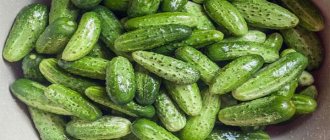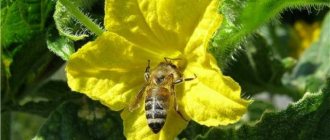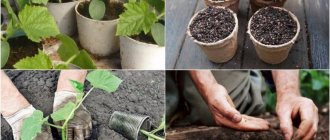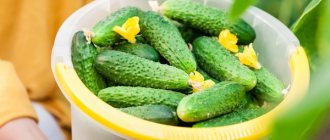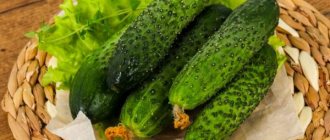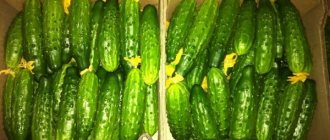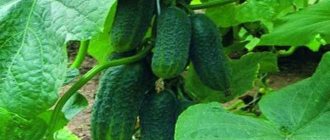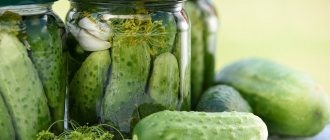Vegetable growing » Cucumbers
0
1691
Article rating
Kira Stoletova
Oktyabrina Ganichkina is a candidate of agricultural sciences, a well-known radio and television presenter, the author of books on gardening, and an active participant in regional agricultural exhibitions. Ganichkina’s advice on planting and growing cucumbers will allow every gardener to improve the quality of the fruit and the yield of the crop.
Growing cucumbers according to the advice of O. Ganichkina
Growing and planting cucumbers according to the advice of O. Ganichkina
Oktyabrina Ganichkina is a candidate of agricultural sciences, a well-known radio and television presenter, the author of books on gardening, and an active participant in regional agricultural exhibitions. Ganichkina’s advice on planting and growing cucumbers will allow every gardener to improve the quality of the fruit and the yield of the crop.
Growing cucumbers according to the advice of O. Ganichkina
Preparing the greenhouse and seedlings
Due to the fact that protected soil creates favorable conditions not only for plants, but also for their diseases, the greenhouse must be disinfected after harvesting or before planting new plants. This is especially true for amateur gardeners who have only 1 greenhouse on their property, where the same crops are constantly grown.
Causative agents of fungal and viral infections that accidentally enter a greenhouse or greenhouse remain in the soil and on all surfaces in the room, quickly spreading when newly planted plants appear.
O. Ganichkina recommends using solutions for treating greenhouses:
- 1 tbsp. l. copper sulfate and 60 g of karbofos per 10 liters of water, with the addition of 1-2 tbsp. l. tar soap. Solution consumption - 1 liter per 100 m². All internal surfaces in the greenhouse need to be sprayed.
- Dissolve the preparations “Iskra DE” (2 tablets) and “Hom” (1 packet) in 10 liters of water. The consumption of the spraying solution is 1 liter per 10 m².
Before spraying, you need to remove all old soil and plant debris from the beds. The following soils have proven themselves to be good for cucumbers:
- loam, humus, peat in a ratio of 4:3:3, respectively;
- loam, humus, peat, sawdust - 4:4:2:1;
- loam and peat in equal proportions (1:1).
After the ridges are filled with new soil, you should add (2 tsp per 1 m²) ash, superphosphate and the preparation “Agricola-5 for pumpkin” and 2 kg of the “Exo” mixture or another marked “for pumpkin”. Chemicals should be spread evenly over the surface of the substrate and embedded to a depth of 10-12 cm.
For intensive growth of cucumbers and the formation of numerous ovaries, the soil must be watered with the Energen stimulant (1 capsule per bucket of water). The solution consumption is 2-3 liters per 1 m².
To obtain an early harvest, O. Ganichkina recommends the seedling method of growing cucumbers. Seeds for seedlings must be sown in such a way that they reach the age of 20-25 days before planting. If there is heating in the greenhouse, you can do this right in it and then just plant the plants at a distance of 50 cm from each other on ridges.
The temperature during growing seedlings should be about 20 ° C during the day and not lower than 12-15 ° C at night. Water consumption for watering seedlings is about 3 liters per 1 m². Upon reaching the phase of 2 true leaves, water with a solution of Agricola Forward fertilizer (2 tbsp per 10 l), the watering rate is 2-3 l per 1 m². After 7-10 days, when 3-4 leaves have formed, feed with a solution of 1 capsule of a root system growth stimulator (cornerost, kornevit) and 1 tbsp. l. complex mineral fertilizer (Kemira-lux or others). Repeat feeding every 7 days, alternating solutions.
Seedless method
Cucumber seeds should be sown in the garden bed in the last ten days of May - early June (depending on the variety). The ideal option would be light neutral or slightly acidic soil, with a high humus content and good light.
To grow cucumbers, it is better to use beds after tomatoes, onions, legumes, early varieties of potatoes and white cabbage. The worst predecessors are cucumbers, zucchini and other pumpkins.
Preparation
The preparation of the bed must begin in the fall, carrying out preventive treatment with a 1% solution of copper sulfate or Bordeaux mixture. After spraying, you need to burn all plant debris and dig up the bed.
In the spring, the area is again dug up deeply and fertilized:
- organic fertilizers (maximum dose 5 kg/m2);
- “Agricola for pumpkin crops” (one package per 3.5-4 m2).
Level the soil with a rake and compress it with plywood or boards, leaving the width of the beds at a maximum of 65-70cm.
Along the resulting beds, it is necessary to draw a furrow (2-3 cm) with a slat. Before planting, according to Ganichkina’s advice, it is better to generously water the furrows twice with a hot biostimulant solution for better growth and setting of greens.
Sowing
Sowing is carried out in warm and moist soil. The seeds do not require preliminary soaking, the distance between them is 50-55cm. To repel pests (ants, slugs, mice, etc.), sprinkle the beds with a mixture of ground peppers (black and red), and the row spacing with dry mustard.
The sown bed must be covered with non-woven material until mid-June to protect the sprouts from low temperatures.
From the second half of June, arches (1 m in height) are used as shelter, on which dense white material is located. It should cover the crops on all sides, protecting them from the sun.
If the cucumber variety is self-pollinating, the shelter is not removed until September (except for the time of fertilizing and moistening). If the crop requires pollination by insects, during flowering the edge of the shelter is raised from the windless side.
Provide your plants with proper care
Cucumber is a heat-loving crop; the optimal temperature for its normal development is 25–27°C. When it drops to 12°, the plant stops its growth and the formation of ovaries.
Before fruit formation begins, crop care is divided into:
- Thinning of seedlings. When sowing, the percentage of seed germination is taken into account, so the seed is placed a little closer to each other than is necessary for full growth. After the second true leaf appears, the plants are thinned out (up to 3 times).
- Weeding. Carefully done weeding will help prevent the growth of weeds and the spread of diseases and pests.
- Watering. It is necessary to water cucumbers (except for the base of the stems) once every 3-4 days with a large amount of warm water at the rate of 2-3 liters per bush.
- Loosening. Performed to establish optimal aeration and moisture capacity of the soil. The last stage of loosening occurs when 4-5 true leaves are formed, when the plants are still vertically directed.
After the start of flowering and especially during the period of fruit formation, care should be concentrated on the following points:
- Watering. The amount of water must be increased to 3-4 liters per plant.
- Fertilizer application. Fertilizers are applied once a week in the form of ready-made organic and mineral fertilizers. Spray the bushes every 2-3 weeks, alternating liquid fertilizers and growth stimulants.
- Formation of the lash. The tops are pinched when the length of the lashes is at least a meter, the length of the side shoots is 45-50cm.
Text of the book “All about tomatoes and cucumbers from Oktyabrina Ganichkina”
Growing cucumbers in open ground
The beds for cucumbers are prepared in advance in a warm and well-lit place where pumpkin crops (cucumbers, zucchini, squash) were not cultivated in the previous year - to prevent infection by diseases and the appearance of pests.
Already in the fall, they choose a bed intended for planting cucumbers for the next year. It is prepared as follows: the bed is treated with the fungicide “Abiga-pik” (75 g per 10 liters of water) at the rate of 1 liter per 10 m2 of bed. After this, all plant debris is removed from the garden bed and burned. The bed is dug to a depth of 20–25 cm and left until spring.
The beds for cucumbers are prepared in advance in a warm and well-lit place.
In the spring, we again dig up a bed up to 70 cm wide to the depth of a spade bayonet. Then we spread organic fertilizer, cultivated peat, compost, manure humus, ready-made substrate for Seliger Agro cucumbers - at the rate of up to 3 kg per 1 m2. Then add wood ash at the rate of 1 cup per 1 m2. After this, we take an iron rake and soil along with organic fertilizers and level it to the depth of the teeth of the rake. The leveled bed is easily compacted with a board or plywood. After this, we make a groove 2-3 cm deep in the middle along the bed - we simply put a slatting on the bed and press it, we get an even groove.
Then prepare a hot solution: dilute 2 tbsp in 10 liters of water at a temperature of 50 °C. spoons of potassium humate “Prompter” for vegetable crops, 10 ml “Intermag Vegetable Garden” for cucumbers, 10 g of growth regulator “Kornevin” and 3 drops of regulator “Emistim”. Stir well and water the entire bed and furrow using sprinkling method, sparing no solution (it is better to water the furrow twice).
Well, now we take the dry seeds of self-fertile cucumber hybrids and sow them in a furrow: seed from seed at a distance of 50–60 cm. Carefully, lightly press the seed with your finger to the warm, moist soil and cover it with moistened loose soil on top - about 1 tbsp is enough. spoons of soil per seed. After this, you need to press the soil onto the seed with your hand.
The sown seeds are not watered from above, but the entire surface of the bed is dusted with ground hot black pepper (you can mix it with red). We do this so that the swollen seeds are not damaged by ants, the emerging seedlings are not eaten by slugs and are not chewed by mice - pepper repels them well.
And the last procedure is to cover the bed with a covering non-woven material, preferably a double layer.
The dates for sowing in such a bed are: May 25, June 1, and the last sowing date is June 15–20. The last sowing date will make it possible to eat fresh green cucumbers even at the beginning of October.
As soon as the threat of frost has passed (June 10–12), the cucumbers are opened, arcs 80–90 cm high are placed on the beds and a dense white covering material is placed on them, covering the bed on all sides. If you do not cover the bed, then the cucumber leaves from the bright sun become very rough, hard and prickly, break, turn yellow, turn brown, and the ovaries turn yellow and dry out. The harvest is quickly disappearing. If the cucumbers are self-pollinating, the covering material is not removed during the summer except for watering, fertilizing and harvesting.
If the cucumbers are bee-pollinated, the covering material during flowering is raised halfway on the warm, windless side.
If light frosts are expected after sowing, then cover the top of the covering material with additional plastic wrap, especially at night.
In the summer, cucumbers are fed almost every 7 days, mainly with ready-made organic and liquid mineral fertilizers.
Root feeding is carried out up to 5–6 times during the summer:
First feeding
carried out 10 days after germination or after planting seedlings: dilute 2 tbsp in 10 liters of water. spoons of potassium humate “Prompter” for vegetables. Consumption up to 2–3 liters per 1 m2; water over the entire surface of the bed.
Second feeding
carried out 6–7 days after the first: dilute 2 tbsp in 10 liters of water. spoons of liquid organic fertilizer “Effecton-O” and potassium humate “Prompter” for green crops, consumption up to 4 liters per 1 m2;
For the third feeding
in 10 liters of water dilute 10 ml “Intermag vegetable garden” for cucumbers and 2 tbsp. spoons of liquid organic fertilizer potassium humate “Prompter” universal, solution consumption 5 liters per 1 m2;
For the fourth feeding
dilute 10 ml of Intermag Vegetable Garden for cucumbers in 10 liters of water, using up to 3 liters of solution per 1 m2;
For the fifth feeding
dilute 2-3 tbsp in 10 liters of water. spoons of liquid organic fertilizer potassium humate “Prompter” universal and “Effecton-O”. Fertilizing is carried out every 7–8 days, strictly monitoring watering. Water only with warm water at least 3 times a week.
Growing cucumbers in greenhouses
Most crops grow well and bear fruit in open ground, but many of them, especially cucumbers, are grown in protected ground to obtain early production. In protected soil, it is possible to artificially create the conditions necessary for normal growth and development of plants. At the same time, the growing time for vegetables in early spring and late autumn is extended due to the protection of plants from frost and sharp temperature fluctuations during the growing season in spring and autumn.
Protected soil is of great importance for growing seedlings of early ripening varieties of vegetable crops, without which it is impossible to obtain early harvests of vegetables in open ground. Types of protected soil include: film or glazed greenhouses, various small-sized portable frame film structures such as a tunnel.
Greenhouse preparation and planting
Disinfection of greenhouses
: in the fall or early spring, the greenhouse is thoroughly disinfected. For 10 liters of water add 1 tbsp. a spoonful of copper sulfate and 40 g of the drug "Karbofos". Add 1-2 tbsp to the solution. spoons of liquid tar soap. Spray the ceiling, especially the corners of the greenhouse, paths, beds, and ground.
Cucumber requires highly fertile, loose soils that are well permeable to air, water and heat.
To grow cucumbers in a new greenhouse, in order to avoid the appearance of pests and diseases, it is better to prepare the beds from ready-made nutrient soil, which is sold in bags of 10, 20, 50 liters. In addition, they use the universal substrate “Exo” and the nutrient soil for cucumbers “Seliger Agro”. The soil is scattered in a layer of up to 18–20 cm. On such beds you can grow for 3–4 years without replacing the soil, with the addition of a nutrient substrate annually.
Craft beds
: beds for cucumbers are best placed from west to east, with a width of 70 to 90 cm, depending on the width of the greenhouse. The passage between the beds should be left 60–70 cm, the passage itself should be tiled, and to prevent the beds from falling apart, you can strengthen them with boards at least 20 cm wide and paint them with any oil paint.
Then the ridges are watered with a solution of liquid organic fertilizer, potassium humate “Prompter” for vegetable crops. To do this, dilute 2 tbsp in 10 liters of warm (50 °C) water. spoons of humate, 10 ml “Intermag Vegetable Garden” for cucumbers, 20 g of growth regulator “Kornevin”, 5 drops of regulator “Emistim”, stir well and water over the surface of the bed, using a solution of 3 liters per 1 m2. Even a small dose of this solution entering the soil leads to the formation of a large amount of humus, thereby significantly increasing soil fertility. Before watering, be sure to pour 10 liters of hot water per 1 m2 onto the beds.
As soon as the ridges are ready, two rows of wire are pulled along each of them at a height of 1.5–2 m, at a distance of 20–30 cm at the top. The wire must be well secured so that it does not break under the weight of the crop. Wipe previously used tension wire with a damp cloth and soap.
Sowing time
: for film greenhouses, seedlings begin to be grown in pots on the windowsill from April 2-5 to April 25-30, in order to plant them in the greenhouse on May 1-20, so that the seedlings are 20-25 days old. If the greenhouse is covered with two layers of film and there is additional heating, then there is no need to grow seedlings at home. Seedlings are grown immediately in a greenhouse in a small bed. The seeds are sown on April 15, and then after 25–30 days (approximately May 1–15), the seedlings are planted over the entire area of the greenhouse, i.e., in a permanent place. If the air temperature drops during the period of seedling growth, it is necessary to cover it inside the greenhouse with a light, light film or special non-woven material: lutrasil, agril, throwing it over temporary arches.
Seeds for seedlings are sown in pots, cups or bags measuring 8x8 or 10x10 cm. Ready-made nutritious soil mixture for cucumbers "Seliger Agro" is poured into the pots. The soil mixture is mixed well and poured to the top into pots, lightly compacted. Then water with a warm (50 °C) solution (10 ml of Intermag Garden for cucumbers is dissolved in 10 liters of water). If the soil mixture has become compacted, you need to add more soil to keep the pot full. Then place the filled pots on the garden bed.
The pots are placed one to one in a bridge manner, i.e., without distances between them. After this, the bed along with the pots is sprayed with a solution before sowing the seeds: 1 tablet of the fungicide “Gamair” is diluted in 1 liter of water, spending 1 liter of solution per 10 m2 (by spraying), to avoid root rot.
When growing seedlings, it is necessary to maintain the temperature at night at least 12–15 °C. At night you need to cover the seedlings warmer, and during the day remove additional covering material. If during the day the air temperature reaches 20 °C or higher and there is no wind, you can open the window on one side of the greenhouse.
The temperature in the greenhouse must be maintained at a constant level (the difference between day and night is no more than 4–6 °C). Too high a temperature causes stretching and weakening of plants, while temperatures below the optimum somewhat inhibit growth without, however, affecting the normal development of plants. The temperature in the greenhouse is regulated by ventilation, which can be increased and made longer as the outside temperature rises, up to the point of opening the door all day and then at night.
It is carried out in such a way that the following temperature is maintained: at night – 17–20 °C, in cloudy weather – 21–23 °C, in sunny weather – 25–28 °C. A little ventilation should be carried out even on cloudy days to avoid too high air humidity, which, together with low temperatures, can provoke plant disease.
The sown seeds, as well as the emerging seedlings, should be watered with a small watering can with very small holes. The rate of watering depends on the growth phase and ambient temperature. To ensure a good supply of water to plants, it is necessary to irrigate in such a way that the water reaches the depth of the roots.
Air humidity when growing seedlings is maintained at 70–85%. Adequate humidity on warm days is maintained by spraying inside the greenhouse. Air humidity above 90% in cloudy weather contributes to the appearance of droplet-liquid moisture on plants, which is favorable for the development of fungal diseases.
Feeding seedlings
: growing cucumber seedlings in greenhouses are fed every 8-10 days. For this purpose, the following solutions are used.
At the first feeding
per 10 liters of water add 2 tbsp. spoons of liquid organic fertilizer potassium humate “Prompter” for vegetable crops, spending from 2 to 3 liters per 1 m2, or 0.5 cups per pot.
Solution for the second feeding
prepared from liquid mineral fertilizer “Intermag Vegetable Garden” for cucumbers: add 10 ml per 10 liters of water, consuming 2 liters of solution per 1 m2. Or add 1 teaspoon of urea, potassium sulfate, superphosphate to 10 liters of water. Consumption from 2 to 3 liters per 1 m2.
When planting seedlings in a permanent place, the plants should have 5–6 true leaves, 1–2 tendrils, a thick stem and a well-developed root system.
Before planting seedlings, carry out moisturizing watering, make holes with a depth corresponding to the size of the pot, add 1 g of Zeba superabsorbent to each hole (this is necessary so that moisture accumulates in the soil next to the root system) and water the holes with a solution of organic fertilizer potassium humate “Prompter” for vegetables, 2 tbsp. spoons per 10 liters of warm (30 °C) water, spending 1 liter per well. The seedlings are planted vertically, filling only the soil pot.
If the seedlings have stretched out a little, then after planting the stem up to the cotyledon leaves can be covered with a 1:1 mixture of peat and sawdust, or with pure peat, or better yet with the universal soil “Exo” or soil for cucumbers “Seliger Agro”.
Seedlings are planted at a distance of 50–60 cm from each other. For better lighting, it is planted in a checkerboard pattern.
Plant care
in protected ground has its own characteristics, mainly due to microclimate regulation, ventilation, watering, fertilizing, processing, formation and harvesting.
When the plants have 8–9 true leaves and have passed frost, they are tied to a wire with polyethylene twine. The plant is formed into one stem, which reaches a length of 1.5 to 2 m, while the side shoots in the lower 3–4 nodes (in the axil of the first lower leaves) are completely plucked out (blinded) at the very beginning of their formation. The remaining side shoots coming from the leaf axils are left 20 to 50 cm long and the tops are pinched. The main stem reaches the wire, and as it grows, it is thrown over both rows of wire and pinched.
Watering and spraying
. Air humidity during the growing season in summer is maintained up to 90–95% (especially on hot sunny days), it is maintained by spraying the paths. Watering is carried out in the greenhouse in the morning. On cloudy days, water less frequently, 1–2 times a week; on sunny days, water 2 to 3 times.
The amount of water consumed depends on the phase of the plant and depending on the weather. Before flowering, water 5–6 liters, during flowering 8–10 liters, during fruiting – 12–18 liters per 1 m2. The temperature in the greenhouse should be 22–28 °C during the day, 17–19 °C at night (the difference between day and night temperatures should be no more than 5–7 °C). Too high a temperature (above 30 °C) causes the plants to stretch and weaken. Therefore, cucumbers grown in greenhouses at high temperatures require high humidity and ventilation; it is enough to open the windows, doors, or, if there is a film greenhouse, lift the film along one of the longitudinal sides.
The temperature in the greenhouse should be 22–28 °C during the day, 17–19 °C at night
Shading
– this operation is recommended, and sometimes simply necessary, when the sunlight is too high and the temperature in the greenhouse is too high. Despite ventilation, the temperature remains elevated, so diffused light is required immediately after planting or when caring for plants. In this case, spray with a weak aqueous solution of chalk on the outside of the heifer.
Soil temperature
during plant development it should be 20–22 °C. The beds are always kept free of weeds. In the first 2–3 weeks, when the plants are still small, very carefully loosen to a depth of 2–3 cm so as not to damage the roots. Subsequently, loosening is carried out depending on how irrigation water flows into the soil. If water does not flow well during watering, this means that the soil has become compacted. Then, using a fork, vertical punctures are made between the rows of plants to the depth of the horns, 4–5 punctures per 1 m2. With this kind of loosening, the root system is not disturbed unless you point the forks in different directions.
Studies have shown that plants develop more intensively and yields increase when the carbon dioxide content in the air increases. Its content can be increased by placing a barrel with manure mash. As manure decomposes, it releases carbon dioxide directly into the air. The mash must be stirred regularly, accelerating the fermentation process, and the cucumbers must also be fed with natural organic fertilizer “Potassium Humate” for vegetable crops: 2 tbsp. spoons are diluted in 10 liters of water and watered to 3 liters of solution per 1 m2. Feeding is carried out once every 10 days in addition to the rest.
Feeding.
When growing cucumbers in a greenhouse, 5–6 fertilizing with mineral and organic fertilizers is carried out over the summer.
Feeding before and during flowering
carried out with the following solution: dilute 2 tbsp per 10 liters of water. spoons of liquid organic fertilizer potassium humate “Prompter” for vegetable crops. At the beginning of flowering, the plants are fed with a solution: 10 ml of Intermag Vegetable Garden for cucumbers and 2 tbsp are diluted per 10 liters of water. spoons of organic fertilizer "Effecton-O".
During fruiting, cucumbers are fed 4 times.
For
the first feeding,
dilute 2 tbsp in 10 liters of water. spoons of organic fertilizer potassium humate “Prompter” for green crops and organic fertilizer “Effecton-O”, spending 5 liters per 1 m2.
Second feeding
carried out after 7–8 days: liquid organic fertilizer potassium humate “Prompter” is diluted into 10 liters of water: universal: 3 tbsp. spoons per 10 liters of water.
Third feeding
repeat after 8 days: dilute 10 ml of Intermag Vegetable Garden liquid fertilizer for cucumbers and 2 tbsp per 10 liters of water. spoons of potassium humate “Prompter” is universal, consuming 5–6 liters of solution per 1 m2.
Fourth feeding
You can prepare green herbs (plantain chickweed / woodlice /, nettle, quinoa), chop and pour 1 kg of this mass into 12 liters of hot water, stir well, leave for a day or more, then strain and water at the rate of 2-3 liters per 1 m2 .
During the growing season, 2-3 foliar feedings are carried out with a solution: 10 ml of Intermag Garden for cucumbers and 3 drops of Emistim growth regulator are diluted in 10 liters of water. Spray at intervals of 10–12 days, starting from the appearance of flower buds.
Garter and shaping
About a week after planting, the seedlings are tied to a trellis with synthetic twine. The twine is tied in a loose loop around the plant, as the thickness of the stem will increase with age. Once a week, the main stem is twisted around the twine, always in the same direction.
For beginning gardeners, shaping a cucumber often causes difficulties, and they pay insufficient attention to this operation. But if the formation is not carried out, then impenetrable thickets will form in the greenhouse, since the plants begin to grow a large number of lateral shoots of the first and second order, which sharply reduces the yield and provokes the development of diseases.
Forming plants will not take much effort if you do it constantly, once a week.
All buds and shoots are removed from the axils of the first 3–5 true leaves (the so-called “blinding”). If this is not done, then ovaries will form in the axils of the first leaves, which will hinder the development of the plant itself, and as a result, the overall yield will decrease. If seedlings are planted in early June, when the weather is warm and the plants grow quickly, then it is enough to blind the axils of 3 leaves; if planting is carried out at the end of April - beginning of May or the plants are weak, then it is advisable to blind 5 sinuses.
The general rule of formation is that the taller the plant, the more shoots and fruits are left on it. Over time, the main stem is thrown over the trellis and pinched, leaving 40–60 cm. As a rule, this is where the formation of the cucumber in the film greenhouse ends.
During the weekly formation of plants, any diseased or yellowed leaves are also removed. All pruning is done in the first half of the day so that the wounds dry out by night.
Harvesting
The quality of the fruit and the duration of fruiting largely depend on proper harvesting. Overgrown fruits take away nutrients and prevent young ovaries from developing, which leads to a decrease in yield.
During the fruiting period, cucumbers are harvested 2-3 times a week, or better yet, every other day (depending on weather conditions). It is best to harvest early in the morning, before the fruits lose their elasticity. Cleaning is carried out carefully, without turning over or moving the lashes. At the same time, not only marketable fruits are picked, but also ugly ones, as well as large fruits remaining from previous harvests (all this allows you to free the plant from unnecessary load).
At the beginning of fruiting, harvesting is carried out 2 times a week, during the period of mass fruiting - every 1–2 days. When the fruits outgrow, they lose their marketable appearance, and their selling price decreases. Cucumbers are harvested early in the morning before the fruits lose their turgor. During the harvest, not only all marketable fruits are picked, but also overgrown and irregularly shaped ones (“hooks”).
Varieties
The number of released cucumber varieties and hybrids increases every year. We list the most promising of them, which can be grown in open and protected ground:
Hermann
– the most popular, super early (38–40 days), super high-yielding hybrid. The fruits are large-tubercular, uniformly cylindrical in shape, 9-11 cm long, without bitterness. Recommended for growing in open and protected ground. Intended for fresh consumption and processing.
Rhythm
– parthenocarpic early hybrid: begins to bear fruit 39–41 days after germination. The fruits ripen smoothly and have an attractive presentation: pimply, standard in size, 8-11 cm long. Tasty both fresh and pickled. The hybrid is resistant to cucumber mosaic virus, cladosporiosis, powdery mildew, and relatively resistant to downy mildew. Transportable.
Caroline
– very early high-yielding hybrid (40–42 days), finely tuberculate. The fruits are homogeneous, cylindrical in shape, high taste, excellent color, without bitterness. Recommended for growing in open and protected ground. Universal use. Self-pollinating. Fruits are 7–8 cm.
Christina
– an early ripening parthenocarpic hybrid for film greenhouses and open ground. Beautiful white-thorned fruits are ready for consumption 40–45 days after germination. The greens are small, lumpy, without bitterness, good fresh and for pickling. Resistant to olive spot, true and downy mildew, and cucumber mosaic virus.
Athos
– early ripening (40–43 days) parthenocarpic hybrid for film greenhouses, shelters and open ground. Plants form 6 fruits in each node. Gherkin fruits are beautiful, 6–9 cm long, finely tuberculate, genetically without bitterness, excellent taste - both fresh and canned. The hybrid is resistant to true and downy mildew, cucumber mosaic virus, and tolerant to olive spot.
A real man
– early, super-high-yielding, super-productive, salad hybrid. The fruits are not smooth, tuberculate, 35–45 cm long, beautiful green in color, without bitterness, heat-resistant. It is recommended to grow in spring and summer in greenhouses of all types.
Marinda
– early ripening high-yielding hybrid. The fruits are large-tubercular with spikes, beautiful dark green in color, 8-12 cm long. Recommended for growing in open and protected ground. Universal use.
Three tankers
– parthenocarpic early ripening (40–45 days) hybrid of predominantly female flowering type. For spring greenhouses and tunnels. The greenery is tuberous, small. It is characterized by a friendly, massive and long-lasting yield. Resistant to olive spot and root rot.
Claudine
– one of the earliest for indoor and open ground. Parthenocarpic, early ripening, high-yielding hybrid with a predominantly female type of flowering. The fruits are of excellent taste and commercial quality: finely tuberous, beautifully shaped, crispy, good for canning, and stored for a long time. Productivity in the greenhouse is up to 28 kg/1 m2.
Parker
– the mid-early hybrid is used for growing in open ground and under temporary film covers. Prone to parthenocarpy (self-pollination). Resistant to cucumber mosaic virus, cladosporiosis, powdery mildew pathogen and root rot. Elegant fruits without bitterness, with excellent taste, pickling. They ripen on the 50th day after emergence.
Artek
– early hybrid (40–42 days), pickling, large-tubercular with black thorns, without bitterness, universal use. Cucumbers weighing 75 g. Recommended for growing in open ground using vertical and horizontal methods. Very crispy, aromatic.
I also recommend new varieties - Gulyai, Russia! The Real Owner, Crispy Bed, Nakhalenok, Shalunishka, Carolina, Zozulya, Tycoon, Christina.
Which is better - variety or hybrid?
Cucumber selection aimed at creating heterotic hybrids has come very far; cucumber is one of those few vegetable crops for which even amateurs prefer hybrids. This is due to the greater advantage of the latter compared to varieties.
Unfortunately, despite the relative cheapness of the seeds, the varieties, unlike modern hybrids, have a number of disadvantages. Of course, even today the varieties have their fans, many gardeners have been growing them for a long time, they are used to them, and besides, some varieties have quite good quality of processed products (some varieties are especially good for pickling). However, they also have many disadvantages: a small number of ovaries on the plant, late fruiting, large fruits, rapid overgrowth and yellowing of greens.
Hybrids differ from varieties in that they form fruits in the absence of pollination; they are called parthenocarpic, according to the type of flowering, hybrids of the female type of flowering (without barren flowers). Typically, gardeners prefer early and mid-season gherkin-type hybrids 6–8 cm long. They mainly choose pickling ones. Based on the nature of the surface of the fruit, it is better to choose finely tuberculate ones. The main criterion: productive and resistant to fungal diseases.
Dear gardeners! Do not try to obtain seeds from hybrids yourself! Otherwise, you risk being left without a harvest! After all, obtaining hybrid seeds is possible only by breeders.
Seedling method
Growing seedlings in a greenhouse is the best way to obtain an early harvest of cucumbers. Closed soil will be more gentle for tender shoots and will protect them from negative environmental factors until the moment of transplanting to the garden bed, when the plants are stronger.
The optimal soil composition for growing cucumber seedlings in greenhouse conditions will be a combination of loam, humus and peat.
Preparation
Preparation for sowing cucumbers in protected soil conditions:
- cleaning of plant residues;
- greenhouse disinfection;
- application of fertilizers and stimulants.
Advantages of planting cucumbers in barrels
Growing cucumbers in a barrel is an easy way to get a plentiful and early harvest without unnecessary hassle, by using old containers that are unsuitable for their intended purpose: a leaky bucket, a large plastic or wooden container without a bottom with a volume of at least 80 liters. A rusty iron barrel is also perfect for creating a “vertical bed”.
Latest articles about gardening
Ammophoska fertilizer: instructions for use
Athlete: fertilizer for seedlings
Vermicompost: what is it and how to use it
There are many of them, for example:
- Saving space on the site.
- Saving on watering and organic fertilizers.
- Possibility of early harvest.
- Less hassle with growing vegetable gardens.
- It looks beautiful in the garden and is pleasing to the eye.
- You can install the barrel in an area that is completely unsuitable for planting a vegetable garden.
- It’s easy to care for, just like taking care of flowers in a flowerpot.
- One barrel replaces an entire bed.
- In the fall, we get excellent compost from the barrel, which can be used to fertilize the beds.
There are a lot of benefits, but what about the costs? Compared to the traditional method, there are significantly fewer of them. Let's take a closer look at how to grow cucumbers in a barrel.
Proper care of cucumbers in a greenhouse: advice from Oktyabrina Ganichkina
TV presenter and author of books on vegetable growing, experienced gardener O. Ganichkina cares for cucumbers in a greenhouse according to the principles she developed, using both the fertilizing method and the formation of a vine.
Maintaining temperature conditions, properly watering, pinching shoots - all these are labor-intensive, but necessary procedures for obtaining a good harvest. Using technologies tested by O. Ganichkina, everyone will be able to obtain high yields of greenhouse cucumbers on their own plot, from early spring to late autumn.
Varieties of cucumbers for growing in a barrel using the Ganichkina method
Cucumber varieties for growing in a barrel should be early, with good yield. Many believe that it is safer to take self-pollinating varieties that produce a large number of female inflorescences - the so-called “girl cucumbers”. Some gardeners recommend planting cucumbers of different varieties in a barrel to increase the fruiting period.
To obtain cucumbers as early as possible, many use the familiar Murom variety - bee-pollinated, but high-yielding, characterized by resistance to frost and pests. Some gardeners recommend the hybrid variety Connie for planting in a cucumber barrel - small, smooth cucumbers with good yield. To obtain fruits of greater weight (about 120 grams), you can use hybrid varieties Courage or German. Even larger fruits are produced by the well-known Zozulya variety (cucumbers with a white side weighing about 260 grams), which can be planted under cover or in open ground.
Forming a lash and caring for cucumbers
By the time of planting on the ridge, the seedlings usually have 5-6 true leaves. Young cucumber bushes need to be planted at a distance of 50-60 cm. Stretch a wire for a trellis over the rows of cucumbers, to which attach pieces of twine of sufficient length so that the bushes can be tied to them. This operation is carried out when the lashes have already grown to 8-9 leaves and lie on the ground.
The formation of a cucumber plant comes down to removing unnecessary shoots.
This way, every fruit will be available for collection, and the lash will receive maximum light. To ensure that the planting is not thickened, each lash is formed.
This is done according to the following scheme (Fig. 1):
- Near the lower 3-4 leaves, remove all shoots and flower buds growing from the axils. O. Ganichkina claims that the fruits growing at the beginning of the vine retard its growth and the formation of subsequent cucumbers.
- Up to a level of 0.5 m from the soil, you need to continue to remove the side shoots completely, but ovaries above 4-5 leaves can already be left.
- The next level (up to a height of 1 m) is formed by retaining part of the side shoot with 1 leaf and ovaries.
- From 1 m to 1.5 m, pinch the side shoots above the 2nd leaf, leaving all the ovaries.
- Starting from a 1.5-meter height, leave the side shoots pinched above the 3rd leaf. As new shoots form on the side shoots, shorten them to 1 leaf with ovaries.
- The stem growing above the trellis must be twisted around the wire and allowed to grow to a length of 40-60 cm, hanging freely down. Then pinch the top.
Planting cucumbers in a barrel using the Ganichkina method
When the air temperature reaches +15-180C, it is time to plant the seeds in a barrel. It is recommended to grow no more than 4-5 cucumber plants in one barrel. Seeds of early cucumber hybrids are suitable for early planting.
During the day, the barrel is well watered, perhaps the contents will settle, then it will be necessary to add soil to the required level. For planting we prepare:
- seeds,
- film,
- scissors,
- twine or elastic band,
- humus.
To plant cucumbers in a barrel, 4 small depressions are formed in the ground, and one cucumber seed is placed in each hole. The hole is filled with humus and the soil is slightly compacted. On the day of planting, the soil is not watered. The barrel is covered with film and tied tightly with twine. It is very convenient to use an elastic band instead of twine; regular underwear will do. There is no need to untie and tie it every time if you need to remove the film. Covering with film will create a greenhouse effect and the seeds will germinate faster. The temperature under the film should not fall below 100C.
If you want, plant more seeds in the barrel, then carefully replant or remove the excess plants. This way you will get cucumber seedlings in a barrel. As the soil dries, the barrel is watered; warm water, for example, heated in the sun, is used for watering. Water from a watering can with a diffuser.
Watering and fertilizing
As the vine grows, the amount of water needs to be increased from 3 liters for seedlings to 5-6 liters at the beginning of flowering, then to 10 liters with the massive appearance of flowers and for good fruit filling - 12-18 liters during the formation of ovaries. The amount of water is given per 1 m².
The following solutions are used for fertilizing:
- "Agricola Forward" 2 tbsp. l per bucket of water - before flowering;
- 1 tbsp. l. complex fertilizer (potassium, phosphorus, nitrogen) and 2 tbsp. l. the drug "Effekton-O" per 10 liters of water - during flowering;
- fertilizers "Agricola for cucumbers" (1 tbsp.) and "Agricola Vegeta" (2 tbsp.) per 10 liters of water - during fruiting.
For 1 m² use 5 liters of solution. Fertilizing during fruiting should be done every 7-10 days.
By forming vines and promptly replenishing the reserves of nutrients and moisture in the soil, you can achieve good yield. Well-groomed plants are less susceptible to diseases, and to get a large number of greens on the vine, you need to choose seeds specifically designed for closed ground (greenhouses or greenhouses).
Preparing barrels for growing cucumbers using the Ganichkina method
As soon as the snow melts, it is necessary to begin preparations. The soil for the barrel can be prepared in the most basic way, which, for example, will consist of compost and soil in a 1:1 ratio.
Also, as soil, you can use any raw food waste or grass from last year. Only this mixture must sometimes be mixed with soil or manure during the soil creation process. When the barrel is full, fertilizer can be added to it to eliminate foreign bacteria.
After this has been added, often only half of the total volume of the container remains in the barrel. Therefore, all procedures must be repeated until it is completely complete. Then, when it’s time to plant the seeds, you need to add another layer of soil about 10-15 cm on top.
Next, the soil is scalded or spilled with a weak solution of potassium permanganate. In the garden, barrels must be installed in such a way that the sun's rays fall on the cucumbers, because if the plants are in a dark area, the yield will be lower than the desired level.
